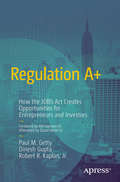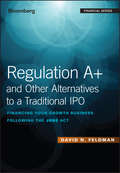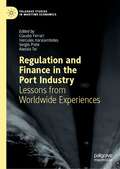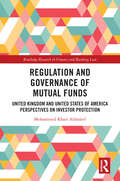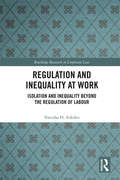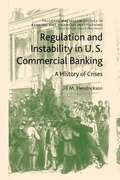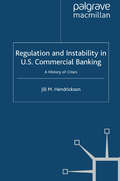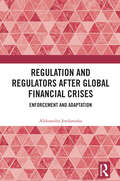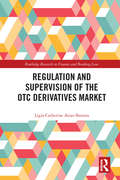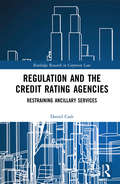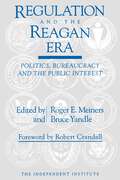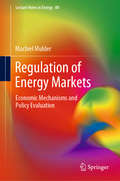- Table View
- List View
Regulating the Collaborative Economy in the European Union Digital Single Market
by Marco IngleseThis book critically assesses how the rise of the collaborative economy in the European Union Digital Single Market is disrupting consolidated legal acquisitions, such as classical internal market categories, as well as the applicability of consumer protection, data protection, and labour and competition law. It argues that the collaborative economy will, sooner or later, require some sort of regulatory intervention from the European Union. This regulatory intervention, far from stifling innovation, will benefit online platforms, service providers and users by providing them with a clearer and more predictable environment in which to conduct their business. Although primarily intended for academics, this book also appeals to a wider readership, including, but not limited to, national and international regulators, private firms and lobbies as well as online platforms, consumer associations and trade unions.
Regulating the Rise of China: Australia’s Foray into Middle Power Economics (Studies in the Political Economy of Public Policy)
by Michael PetersThis book revises the existing account of the first Rudd Government's engagement with China, placing Australian foreign direct investment screening policy at the centre of the story. At the time, the Rudd Government was accused of holding an unnecessarily interventionist approach to Chinese Sovereign-Owned Enterprise investments into the Australian mining sector. This book claims that the Australian Government had a deep and coherent understanding of the problem posed by Chinese investments that went well-beyond any simplistic 'China Inc.' or geopolitical threats. The key policymakers believed that the Chinese state-directed investments threatened the integrity of the liberal governance structures on which the Australian state is founded, and so Australian sovereignty itself. While the response of the Rudd Government was largely ineffectual, the logic underpinning it remains the best framework for guiding Australia's engagement with China into the 2020s, as well as the engagement of other liberal states coming to grips with China's rise.
Regulating the Takeover of Chinese Listed Companies
by Juan ChenThis book provides a comprehensive review of the Measures for Administration of Takeover of Chinese Listed Companies (the Chinese takeover law), with emphasis on the differences between the Chinese takeover law and takeover legislation in the UK, the US and Hong Kong. The Chinese M&A market has been booming at an unprecedented rate in recent years; not only domestic investors, but also foreign funds and multinational companies are actively participating on the market. For both market participants and researchers, it is crucial to understand the emerging and transitional aspects of the Chinese economy and its M&A market, and the impacts of those aspects on relevant laws. While there are ongoing academic discussions on the convergence between the Chinese takeover law and its counterparts in the UK, Hong Kong and the US, this book offers a comprehensive discussion of the divergence and focuses on key differences in the transplanted Chinese takeover law.
Regulating to Disaster
by Diana Furchtgott-RothWhat is a "green job" anyway? Few can adequately define one. Even the government isn't sure, you will learn in these pages. Still, President Obama and environmentalist coalitions such as the BlueGreen Alliance claim the creation of green jobs can save America's economy, and are worth taxpayers' investment.But in Regulating to Disaster, Diana Furchtgott-Roth debunks that myth. Instead, energy prices rise dramatically and America's economic growth and employment rate suffer - in some states much more than others - when government invests in nonviable ventures such as the bankrupted Solyndra, which the Obama Administration propped up far too long.Electric cars, solar energy, wind farms, biofuels: President Obama's insistence on these dubious pursuits ultimately hamstrings American businesses not deemed green enough, and squeezes struggling households with regulations. Adding insult to injury: the technology subsidies Americans pay for solar panels, wind turbines, and electric batteries really help create manufacturing jobs in China and South Korea.Green jobs are the most recent reappearance of a perennial bad idea - government regulation of certain industries, designed to anoint winners and losers in the marketplace. Regulating to Disaster reveals the powerful nexus of union leaders, environmentalists, and lobbyists who dreamed up these hoaxes, and benefit politically and financially from green jobs policies. Unfortunately, there are more Solyndras on the horizon, and our economy is in no shape to absorb them.
Regulation A+
by Paul M. Getty Dinesh Gupta Robert R. Kaplan"This book is a must-read for all entrepreneurs who need to raise capital to grow their businesses. " --from the Foreword by Bill Hambrecht, Founder and Chairman, WR Hambrecht + Co "We congratulate the authors for bringing together many of the elements needed to help corporations and their investors take advantage of Reg A+ in a simple and easy-to-understand guide. " --from the Afterword by David Weild IV, Founder and CEO, Weild & Co. ; Former Vice Chairman of NASDAQ; "Father" of the JOBS Act Discover how to raise money under the SEC''s long-awaited Regulation A+ implementing Title IV of the JOBS Act. This ground-breaking book is the authoritative guide to Reg A+ for executives of emerging growth companies, entrepreneurs, financial advisers, venture capitalists, investment bankers, securities lawyers, and finance and MBA students on how to raise up to $50 million a year through what is in effect a new type of IPO unencumbered by the heavy regulation and cost of a traditional IPO. Reg A+ lifts many of the constraints on soliciting funds, raising growth capital through public offerings, and trading new stock issues that till now inhibited the growth of small companies. The SEC rules implementing Title III of the JOBS Act by expanding equity crowdfunding to non-accredited investors and allowing small businesses to raise up to $1 million per year have been greeted with speculative excitement in the startup space. But investment banking and stock market heavy hitters such as Bill Hambrecht and David Weild believe that Reg A+ will have a much greater economic impact than the crowdfunding rules and will launch a revolutionary period of growth, innovation, investment returns, and job creation. Paul Getty, Dinesh Gupta, and Robert Kaplan pool their experience as serial entrepreneurs, investors, and lawyers to show readers in very practical terms how to take maximum advantage of the powerful provisions of the Reg A+ that permit companies to raise up to $50 million--a tenfold increase over the old Reg A limit of $5 million and fifty times the crowdfunding limit allow companies to market IPOs to more people than just accredited investors make it easier to get the word out on offerings exempt companies under certain conditions from onerous and costly reporting and compliance requirements, such as Sarbanes-Oxley What you''ll learn How Title IV of the JOBS Act amends Regulation A, making it easier for you to raise up to $50 million in expansion capital while avoiding burdensome regulations. How raising funds through Regulation A might now be a better and less costly choice for raising capital than current options (like loans or venture capital). How to use Regulation A to gain liquidity for your business, your employees, and your investors--while maintaining control. How to abide by Regulation A rules before, during, and after an IPO. What kinds of businesses can take part in Regulation A offerings. How and where to trade shares after the IPO. Who this book is for Executives of emerging growth companies, entrepreneurs, financial advisers, venture capitalists, investment bankers, securities lawyers, finance and MBA students, and others. Table of Contents Chapter 1 Introduction Chapter 2 Overcoming Challenges to Going Public Chapter 3 Benefits of Regulation A+ Chapter 4 Limitations and Business Line Considerations Chapter 5 The Key Elements of a Reg A+ Offering Chapter 6 Raising the Capital through an Underwriter Chapter 7 Post-IPO Activities Chapter 8 Secondary Markets and Regulation A+ Securities Chapter 9 Final Thoughts Appendix A Current Legal Authority Appendix B Current Guidance from SEC Appendix C Public Statements of Commissioners at Open Meeting to Adopt Regulation A+ Appendix D OTC QX/OTC QB Listing Requirements and On-Ramp Guides Appendix E Offering Statement Exemplars Appendix F: Blue Sky Glossary
Regulation A+ and Other Alternatives to a Traditional IPO: Financing Your Growth Business Following the JOBS Act
by David N. FeldmanUnderstand Regulation A+ and other alternative funding methods Regulation A+ and Other Alternatives to a Traditional IPO delves into the details of the new SEC rules under the JOBS Act of 2012 to examine the benefits and pitfalls for entrepreneurs and investors. Written by the 'Godfather of Reg A+,' this book breaks down the complex details of Regulation A+ and other alternative funding methods to help small businesses determine how best to go public and raise capital. A traditional IPO comes with barriers that can be insurmountable for a small company seeking to enter the public markets; thus far, reverse mergers have provided a challenging 'back door' to the market, but Regulation A+ re-opens the front door to allow small cap companies to raise capital while keeping offering and compliance costs manageable in a way not possible with a traditional IPO. More complex than simple crowdfunding, yet just as accessible by all investors, Regulation A+ is a step up for entrepreneurs at any stage wanting to go public where Wall Street meets Main Street. Straightforward explanations, smart strategy, and illustrative examples make this book an invaluable guide for those seeking to truly understand the nuances of Regulation A+ in order to work more effectively within its bounds. Understand how Regulation A+ differs from a traditional IPO and the early experience with this exciting new approach Examine the JOBS Act and the SEC's rules under Title IV Explore the past, present, and future of reverse mergers, special purpose acquisition companies (SPACs) and self-filings Discover new alternatives including new rules under Rule 504 and Regulation S The new rules provide a faster, more streamlined, more cost-effective route to up to $50 million in capital, and offer companies more flexibility than ever. Every entrepreneur needs to know all available funding options, and Regulation A+ and Other Alternatives to a Traditional IPO provides essential guidance from the expert in the field.
Regulation Theory: The State of the Art
by Robert Boyer Yves SaillardRobert Boyer and Yves Sailard's Theorie de la Regulation introduces the Francophone public to one of the most important new currents in social science of the past half-century. This long-awaited translation will help broaden its impact still further.Regulation Theory focuses on the structural features of a given model and has helped enliven the examination of core economic concepts.
Regulation and Finance in the Port Industry: Lessons from Worldwide Experiences (Palgrave Studies in Maritime Economics)
by Claudio Ferrari Alessio Tei Hercules Haralambides Sergio PreteThis book addresses the latest organizational, regulatory, and governance issues of main port systems, linking them to the financial aspects that are currently in use regarding investments in the port industry. A general review of port management and operations is complimented by analysis of country specific systems and a look at how ports could develop in the future. This book aims to examine how different port organizational and regulatory contexts affect port investment practices and related financial tools. The book is of use to researchers and practitioners interested in maritime economics and transportation studies.
Regulation and Governance of Mutual Funds: United Kingdom and United States of America Perspectives on Investor Protection (Routledge Research in Finance and Banking Law)
by Mohammed Khair AlshaleelThis book provides a detailed analysis of mutual fund regulations and governance in the UK from the investor protection perspective. It comprehensively describes mutual funds by their function, social utility, and legal attributes, examining the level of protection provided to retail investors under existing regulations. Mutual funds are externally managed with fund ownership separated out from their management, which carries a potential conflict of interest between the self-interests of the fund management and each fund’s investors. The book provides an in-depth analysis of this agency problem in the mutual fund industry, comparing the competing governance models in the UK and the US and the supervision of management activities. In the UK, it investigates the main governance mechanisms, including disclosure, the effectiveness of voting rights, and the role of the Financial Conduct Authority in protecting investors. It also considers the role of prudential regulations in protecting mutual fund investors, with a particular focus on risk management and mutual fund liquidity crisis. The book further investigates the impact of the withdrawal of the UK from the European Union (Brexit) on the industry and what this means for the future of the undertakings for collective investment in transferable securities (UCITS) in the UK. The concept of mutual funds is still not clearly understood, so this book will clearly define the different legal and practical aspects of mutual funds. It will be the first substantial study of mutual fund governance mechanisms under the existing mutual fund laws and regulations in the UK.
Regulation and Inequality at Work: Isolation and Inequality Beyond the Regulation of Labour (Routledge Research in Corporate Law)
by Vanisha SukdeoThis book examines how the law has limitations to the extent that it can combat repression, isolation, and inequality. The main point the book explores is that isolation and inequality cannot be solved by driving up wages and having better working conditions. The true divide between management and workers is the inability of management to see the workers as people, and not just numbers. "The Swiss novelist Max Frisch remarked at the time, ‘We imported workers and got men instead.’" This encapsulates the dilemma of management – how to distance one’s self enough from workers to command respect yet not too distant as to be seen as inhumane. How can isolation and inequality within the workplace be overcome? Regulation and Inequality at Work shows how workers can have an increased voice by using tools outside of the typical legal ones. Without state protection, the rights can be viewed as less stringent. Working outside the system allows for greater malleability and flexibility to be able to cater to individual workers in individual workplaces. Workers’ rights are about better working conditions, hourly wages, and benefits, but are also about being treated in a more civilized manner where one’s humanity is recognized. Only through all of these parts working together will a true version of workers’ rights emerge—one where workers are not viewed as mere tools but within and of the system itself. It shows the latest state of knowledge on the topic and will be of interest both to students at an advanced level, academics and reflective practitioners in the fields of business and company law, labour law, and employment law.
Regulation and Instability in U.S. Commercial Banking
by Jill M. HendricksonFinancial crises take us by surprise and make us ask how this could have happened. We also immediately try to understand how crises can be kept from reoccurring. In the United States, the response to a bank crisis has always been more regulation. This book seeks to understand the history of bank crises and to reconcile how, over the course of history, we have more regulation and heightened instability. From the antebellum era through the most recent real estate driven bank crisis, this book carefully considers the relationship between regulation and bank stability. In the end, the regulation stifles competition and inadvertently encourages banks to take on additional risk. As regulators and policymakers contemplate their response to the 2007-2009 crisis, the certain tendency will be towards more regulation. Unfortunately, this response inevitably will lead to another crisis in the future.
Regulation and Instability in U.S. Commercial Banking: A History of Crises (Palgrave Macmillan Studies in Banking and Financial Institutions)
by Jill M. HendricksonRegulation and Instability in U.S. Commercial Banking.
Regulation and Instability in U.S. Commercial Banking: A History of Crises (Palgrave Macmillan Studies in Banking and Financial Institutions)
by Jill M. HendricksonThe historical response to bank crises has always been more regulation. A pattern emerges that some may find surprising: regulation often contributes to bank instability. It suppresses competition and effective response to market changes and encourages bankers to take on additional risk. This book offers a valuable history lesson for policy makers.
Regulation and Organisations: International Perspectives (Routledge Advances in Management and Business Studies #28)
by Glenn Morgan Lars EngwallDuring the 1980s and 1990s, organisations have undergone both regulation and deregulation. This set of papers written by a distinguished selection of international experts examines the nature of regulation, its evolution in particular sectors and its impact on social and economic equality. It draws on social theory concerned with the nature of regulation and order in modern societies as well as providing as a series of detailed analyses of particular forms of regulatory regimes in national and international contexts. The book should be of particular interest to management and business researchers, sociologists and political economists concerned with the process of regulation and its impact on organisations and management.
Regulation and Organizations: International Perspectives (Routledge Library Editions: Industrial Economics #28)
by Glenn Morgan Lars EngwallDuring the 1980s and 1990s, organisations have undergone both regulation and deregulation. This set of papers written by a distinguished selection of international experts examines the nature of regulation, its evolution in particular sectors and its impact on social and economic equality. It draws on social theory concerned with the nature of regulation and order in modern societies as well as providing as a series of detailed analyses of particular forms of regulatory regimes in national and international contexts. This book, first published in 1999, should be of particular interest to management and business researchers, sociologists and political economists concerned with the process of regulation and its impact on organisations and management.
Regulation and Regulators after Global Financial Crises: Enforcement and Adaptation
by Aleksandra JordanoskaThis book provides an original theoretically and empirically grounded analysis of regulatory enforcement activism in post-crisis periods and the ensuing regulatory interactions. It critically addresses the ‘more regulation’ enforcement agenda relating to financial misconduct in the aftermath of the 2008 financial crisis, showing how misconduct was constructed through the enforcement policies and practices of the powerful UK financial conduct regulator and its interactions with the subjects of enforcement proceedings and their legal representatives during a tumultuous time in the financial markets. Drawing from interviews with regulators, professional intermediaries, and markets participants; documentary analysis of enforcement decisions and speeches; and observations, the volume adopts an interdisciplinary approach grounded in social constructivist perspectives on compliance and deviance, regulation theory, and socio-legal research. Through a multi-dimensional analytical framework of regulatory enforcement activism that links shifts in regulatory policymaking; experimentations with legal powers in information-gathering, legal and extra-legal penalties, and individual accountability; and the use of enforcement tools in micro-level interactions, the book documents a more interventionist and punitive post-crisis enforcement agenda. The findings challenge current thinking in the 'scandal and reform' literature. The work argues that despite the increased focus on enforcement, it is not necessarily the case that the power has tilted more towards the regulator. This fine-grained socio-legal enquiry makes innovative and timely theoretical contributions to our understanding of the limitations of regulatory activism and regulatory control, regulatory relationships, the governance of financial markets, and broader thinking on regulating corporations and the individuals within them. It will appeal to academics, researchers, regulators, and policymakers working in regulation across law, criminology, sociology, and politics.
Regulation and Supervision of the OTC Derivatives Market (Routledge Research in Finance and Banking Law)
by Ligia Catherine Arias-BarreraThe over-the-counter (OTC) derivatives market has captured the attention of regulators after the Global Financial Crisis due to the risk it poses to financial stability. Under the post-crisis regulatory reform the concentration of business, and risks, among a few major players is changed by the concentration of a large portion of transactions in the new market infrastructures, the Central Counterparties (CCPs). This book, for the first time, analyses the regulatory response of the United Kingdom and the United States, the two largest centres of OTC derivatives transactions, and highlights their shortcomings. The book uses a normative risk-based approach to regulation as a methodological lens to analyse the UK regime of CCPs in the OTC derivatives market. It specifically focuses on prudential supervision and conduct of business rules governing OTC derivatives transactions and the move towards enhancing the use of central clearing. The resulting analysis, from a normative risk based approach, suggests that the UK regime for CCPs does not fulfil what would be expected if a coherent risk based approach was taken. Our comments on the Dodd-Frank Act highlight that the incoherent adoption of risk-based approach to regulation affects the effectiveness of the US regime for CCPs. Such a regime does not follow the pace of events of ‘innovation risk’; in particular, the foreseeable changes FinTech will bring to the OTCDM and central clearing services. The second inadequacy of the US regime concerns the dual regulatory structure of the CFTC and the SEC, and the inadequate adoption of different and not well-coordinated regulatory strategies. We also analyse the cross-border implications of the US regime for non-US CCPs that provide clearing services to US market participants. Finally, we study the negative effects of the absence of a clearly defined resolution regime for CCPs.
Regulation and the Credit Rating Agencies: Restraining Ancillary Services (Routledge Research in Corporate Law)
by Daniel CashThis book examines the transgressions of the credit rating agencies before, during and after the recent financial crisis. It proposes that by restricting the agencies’ ability to offer ancillary services there stands the opportunity to limit, in an achievable and practical manner, the potentially negative effect that the Big Three rating agencies – Standard & Poor’s, Moody’s and Fitch – may have upon the financial sector and society moreover. The book contains an extensive and in-depth discussion about how the agencies ascended to their current position, why they were able to do so and ultimately their behaviour once their position was cemented. This work offers a new framework for the reader to follow, suggesting that investors, issuers and the state have a ‘desired’ version of the agencies in their thinking and operate upon that basis when, in fact, those imagined agencies do not exist, as demonstrated by the ‘actual’ conduct of the agencies. The book primarily aims to uncover this divergence and reveal the ‘real’ credit rating agencies, and then on that basis propose a real and potentially achievable reform to limit the negative effects that result from poor performance in this Industry. It addresses the topics with regard to financial regulation and the financial crisis, and will be of interest to legal scholars interested in the intersection between business and he law as well as researchers, academics, policymakers, industry and professional associations and students in the fields of corporate law, banking and finance law, financial regulation, corporate governance and corporate finance.
Regulation and the Reagan Era: Politics, Bureaucracy and the Public Interest
by Robert Crandall Roger E. Meiners Bruce YandleWas the so-called "Reagan Revolution" a disappointment regarding the federal systems of special-interest regulation? Many of that administration&’s friends as well as its opponents think so. But under what criteria? To what extent? And why?When Ronald Reagan was elected in 1980, the popular belief was that the size of government would be cut and that some of the regulatory excesses of the prior decade would be rolled back. However, the growth of the federal government continued throughout the Reagan presidency and no agencies were phased out. What were the apparently powerful forces that rendered most of the bureaucracy impervious to reform? In this book, professional economists and lawyers who were at, or near, the top of the decision-making process in various federal agencies during the Reagan years discuss attempts to reign in the bureaucracy. Their candid comments and personal insights shed new light on the susceptibility of the American government to bureaucratic interests. This book is required reading for anyone wishing to understand the true reasons why meaningful, effective governmental reform at the federal level is so difficult, regardless of which political party controls the White House or Congress.
Regulation by Municipal Licensing
by John Palmer John Bossons S. M. Makuch Peter QuanceMunicipal licensing serves a variety of regulatory purposes such as consumer protection and public health and safety. The municipal licensing power is delegated from the provincial government, up to the present, municipalities have been restricted to enumerated, specific powers, and the result has been the growth of a disorganized and unwieldy accumulation of bylaws, many of which conflict or are obsolete. The development of a two-tier system of municipal government, exemplified by Metropolitan Toronto, adds to the complexity of the issues. Basing their analysis upon municipal experience in Ontario, the authors envisage a reorganized system in which provincial and municipal powers will be exercised more rationally to deal with problems at the level at which they tend to occur.Municipal licensing in practice is the topic of a study of the cartage and taxicab industries in a number of Canadian and American cities. Comparisons of industry structure in differing regulatory environments lead to the conclusion that entry controls are not justified by their results.
Regulation in the European Electricity Sector (Routledge Research in Energy Law and Regulation)
by Maciej M SokołowskiSince the very beginning of European integration, electricity has been within the legal sphere of the EU. Much of this is found within the binding European acts making up the framework of the Energy Packages. The established legal institutions have had a significant impact on the shape of the energy market in Europe. Nevertheless, the European energy market still seems to be developing, as demonstrated by the current lively discussion about the state of the Energy Union. Regulation in the European Electricity Sector delves into European energy law and reflects on some of the primary issues related to the public legal impact on the European energy sector. The book offers a brief explanation of the background operation of the electricity sector, as well as liberalisation within the area, and traces the evolution of the EU’s approach towards the issue of public law regulation within the electricity sector. Finally, the book presents an analysis of European and national laws, considering their interpretation, and explores the future of public law regulation. Aimed at giving the reader a deep insight into a nature of the state’s presence in the power sector, this book will be of great interest to students and scholars of EU energy law and policy.
Regulation of Cryptocurrencies and Blockchain Technologies: National and International Perspectives (Palgrave Studies in Financial Services Technology)
by Rosario GirasaThe book highlights the rise of Bitcoin, which is based on blockchain technology, and some of the many types of coins and tokens that emerged thereafter. Although Bitcoin and other cryptocurrencies have made national and international news with their dramatic rise and decline in value, nevertheless the underlying technology is being adopted by both industry and governments, which have noted the benefits of speed, cost efficiency, and protection from hacking. Based on numerous downloaded articles, laws, cases, and other materials, the book discusses the digital transformation, the types of cryptocurrencies, key actors, and the benefits and risks. It also addresses legal issues of digital technology and the evolving U.S. federal regulation. The varying treatment by individual U.S. states is reviewed together with attempts by organizations to arrive at a uniform regulatory regime. Both civil and criminal prosecutions are highlighted with an examination of the major cases that have arisen. Whether and how to tax cryptocurrency transactions both in the U.S. and internationally are analyzed, and ends with a speculative narrative of future developments.
Regulation of Cryptocurrencies and Blockchain Technologies: National and International Perspectives (Palgrave Studies in Financial Services Technology)
by Rosario GirasaThis second edition further explores the regulatory landscape of cryptocurrency, highlighting the rise of Bitcoin, which is based on blockchain technology, and some of the many types of coins and tokens that emerged thereafter. Although Bitcoin and other cryptocurrencies have made national and international news with their dramatic rise and decline in value, nevertheless the underlying technology is being adopted by both industry and governments, which have noted the benefits of speed, cost efficiency, and protection from hacking. Based on numerous downloaded articles, laws, cases, and other materials, the book discusses the digital transformation, the types of cryptocurrencies, key actors, and the benefits and risks. It also addresses legal issues of digital technology and the evolving U.S. federal regulation. The varying treatment by individual U.S. states is reviewed together with attempts by organizations to arrive at a uniform regulatory regime. Both civil and criminal prosecutions are highlighted with an examination of the major cases that have arisen. This second edition specifically explores the creation of stablecoins, governments issuance of their own versions of digital currencies, new regulations that have been enacted and promulgated, and a clearer examination of futuristic evolutions that potentially will have a major impact upon the current cited technologies.
Regulation of Debt Collection in Europe: Understanding Informal Debt Collection Practices (Routledge Research in Finance and Banking Law)
by Cătălin-Gabriel StănescuDue to the absence of due process and other procedural guarantees generally offered by judicial enforcement, informal debt collection practices (IDCPs) can become abusive, harming both consumers and the economy by threatening consumers’ physical, psychological, and economic wellbeing; exposing law-abiding debt collectors to unfair competition; undermining the financial system, and negatively impacting social peace by resorting to criminal activity. The need to control and harmonize IDCPs surfaced in connection with the European Commission’s Action Plan to tackle the high level of non-performing loans caused by the financial crisis and the Covid-19 pandemic - specifically the Proposal for a Directive on Credit Servicers, Credit Purchasers, and the Recovery of Collateral (CSD). Harmonizing the regulation of abusive IDCPs is vital for several reasons. First, IDCPs have a cross-border dimension due to the freedom of movement, enabling debt collection operations across the internal market. Second, the internal market’s size amounts to over 450 million citizens potentially exposed to abusive IDCPs. The regulatory frameworks addressing IDCPs in the EU display divergent characteristics that may be difficult to navigate and require creating a level-playing field for consumers and debt collectors, especially when approaches vary at Member State level. This book addresses this gap by providing a comprehensive guide to regulating informal debt collection practices in eight Member States (MS) of the EU and the United Kingdom (UK). It serves as a comparative law instrument for implementing the recently adopted Credit Servicers Directive (CSD). It will be important reading for students, academics and stakeholders with an interest in debt collection practices and the law.
Regulation of Energy Markets: Economic Mechanisms and Policy Evaluation (Lecture Notes in Energy #80)
by Machiel MulderThis textbook explains the main economic mechanisms behind energy markets and assesses how governments can implement policies to improve how these markets function. Adopting a micro-economic perspective, the book systematically analyses the various types of market failures on the electricity and gas markets as well as coal, oil, hydrogen and heat markets to identify government policies that can improve welfare. These shortcomings include the natural monopoly and the public-good character of energy infrastructures; market power resulting from inflexibility of supply and demand; international trade restrictions; negative externalities concerning the use of fossil energy; positive externalities concerning innovative new energy technologies; information asymmetries with regard to the product characteristics of energy commodities; and other public concerns, such as energy poverty. In turn, readers will learn about various measures that governments can use to address these market failures, including incentive regulation for electricity grids; international integration of wholesale energy markets; environmental regulatory measures like emissions trading schemes; subsidy schemes for new technologies; green-energy certificate schemes; and energy taxes. Given its scope, the book will appeal to upper-undergraduate and graduate students from various disciplines who want to learn more about the economics and regulation of energy systems and markets.




